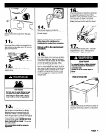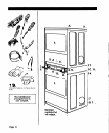
Exhaust
requirements
Fire Hazard
Do Not use non-metal, tlexlble duct.
Do Not use metal duct smaller than
10.2 cm (tour Inches) In diameter.
Do Not use exhaust hoods wlth
metal latches.
Check that exhaust system Is not
longer than specltled. Exhaust
system longer than speclfled will:
- Accumulate Ilnt.
- Shorten the llfe ot the dryer.
- Reduce the performance,
resulting In longer drylng times
and Increased energy usage.
Failure to
r0ii0w
specltlcatlons may
result In a tire.
Do Not exhaust dryers Into a
chimney, turnace cold alr duct,
alilc or crawl space, or any other
duct used ror ventlng.
Clean the exhaust system every
other year.
Do Not Install tlexlble duct In
enclosed walls, celllngs or floors.
Accumulated lint could result In a
fire or cause moisture damage.
Exhaust dryers outslde to prevent
exposure to substances In gas
tuels and combustion which may
be harmful to your health.
The moisture and llnt Indoors may
cause:
- FIRE HAZARD tram llnt collected In
dryer.
- Moisture damage to woodwork,
furniture, palnt, wallpaper, carpet,
etc.
- Housecleanlng problems and
possible health problems.
Failure to tallow these lnstructlons
could result In a tlre or Inlury.
ixhaust materials are not supplled.
It uslng an exlstlng exhaust system,
clean llnt from entlre length ot
exhaust system. Make sure exhaust
hood Is not plugged wlth Ilnt.
The exhaust system should be
Inspected and cleaned yearly.
Replace any vlnyl or metalllzed
plastic toll exhaust duct wlth rlgld
metal or tlexlble metal duct.
Use duct tape
to seal
all joints. Do Not use
screws to secure duct.
10.2-cm (tour-
Inch) metal
exhaust duct
is
required. Plan
installation to
use the fewest
exhaust air tlow
better
good
number of elbows
and turns,
i?zJ
Metal tlexlble duct
must be fully
extended and supported when the
dryers are in final position, DO NOT
KINK OR CRUSH THE DUCT. The metal
flexible duct must be completely
open to allow adequate exhaust air
to flow.
Allow as much room as possible when
using elbows or making turns. Bend
duct gradually to avoid kinking.
Remove excess flexible duct to avoid
sagging and kinking that may cause
reduced airflow.
The external exhaust ducts
can be
routed straight out the back of the
dryers. Kits are available to convert
the external exhaust duct to be
routed right, left or through the
bottom (See Page 6). Product
dimensions and recessed area
requirements are given on Page 7.
Slde or bottom exhaust:
The
maximum length of the exhaust
system through the side or bottom is
4.9 m (16 feet) wlth two external
elbows and hood.
Rear exhaust:
The maximum length of
the exhaust system depends on the
type of duct, the number of elbows
and the type of exhaust hood. The
maximum length for both rigid and
flexible duct is shown in the chart.
Thls chart applies only to lndlvldually
exhausted unlts.
I
EXHAUST HOOD TYPE
E!$i2 9;s
IQ2 all (4-l
I(12 cm (F
WIMUM LENGTH OF 10.2~cm (4-inch) DIAMEIERRIGID MEIAL DUC
0 13.1 m (43’) 12.5 m (41’) 11.0 m (36’)
1 10.1 m (33’)
9.4
m (31’)
7.9
m (26’)
2 7.0
m (23’)
6.4
m (21’)
4.9
m (16’)
I
I
I
AXIMUM IfNGiH OF 10.2~cm @-inch) DIAMETER FLWBLE METAL DUC
0
9.1 m (JO’)
8.8
m (29’)
7.3
m (24’)
1
7.3
m (24’)
7.0
m (23’) 5.5 m (18’)
2 4.9
m (16’)
4.6
m (15’)
3.0
m (10’)
For
exhaust systems
not covered by
the exhaust length chart, see
WhirtDool Service Manual, “Exhausting
Whirlpool Dryers,” Part No. 603197,
available from your Whirlpool parts
distributor.
Service check:
The back pressure in
any exhaust system used must not
exceed 0.6 inches of water column
measured with an incline manometer
at the point that the exhaust system
connects to the dryers.
If dryers are Installed In a conflned
area
such as a bedroom, bathroom
or closet, they must be exhausted to
the outslde and provislon must be
made for enough air for combustion
and ventilation. (Check governing
codes and ordinances. Also refer to
the “Recessed area and closet
installation instructions,” Page 7.)
An
exhaust hood
should cap the
exhaust duct to prevent exhausted
air from returning into the dryers. The
outlet hood must be at least 30.5 cm
(12 inches) from the ground or any
object that may be in the path of the
exhaust.
10.2-cm (four-Inch) outlet hood ls
preferred.
However, a 6.4-cm (2-l /2-
inch) outlet exhaust hood may be
used. (A 64cm (2-l/2-inch) outlet
creates greater back pressure than
other hoods.)
A maln exhaust duct
can be used for
exhausting a group of dryers. Main
exhaust duct should be sized to
remove 18.6 CCM (200 CFM) of air
per dryer. Large-capacity lint screens
of proper design may be used in the
main exhaust duct if checked and
cleaned frequently. The room where
the dryers are located should have
make-up air equal to or greater than
the CFM of all the dryers in the room.
airflow - maincolleciorducl -
Back-drattdamper kits
(Part No.
3391910) are available from your
Whirlpool dealer and should be
installed in each dryer’s exhaust duct
to prevent exhausted air from
returning into the dryers and to keep
the exhaust balance within the main
exhaust duct. Unobstructed air
openings are required.
Each exhaust duct
should enter the
main duct at an angle pointing in the
direction of the airflow. Ducts
entering from the opposite side
should be staggered to reduce the
exhausted alr from interfering with the
other ducts,
The
maxlmum angle
of each duct
entering the main duct should be no
more than 30”.
Page 5














